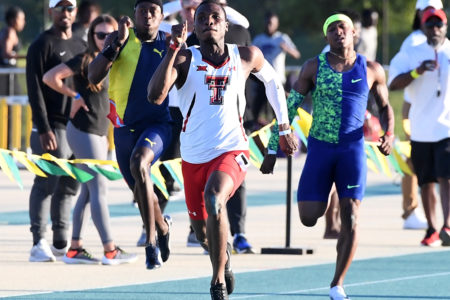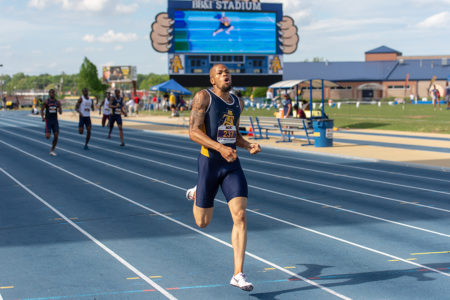 OG, DQ, FS, NWI, NH, WR, etc., etc., etc. Track & field is full of initialisms and acronyms. And any serious statistician/historian of our sport knows well the initials RLQ, which stand for the now-departed Roberto Luigi Quercetani. Roberto was already a giant in the sport when I came on board at T&FN in late-’69 and continued to be one for decades to come. It’s amazing for me to realize what a long relationship we had, one that started even before we met.
OG, DQ, FS, NWI, NH, WR, etc., etc., etc. Track & field is full of initialisms and acronyms. And any serious statistician/historian of our sport knows well the initials RLQ, which stand for the now-departed Roberto Luigi Quercetani. Roberto was already a giant in the sport when I came on board at T&FN in late-’69 and continued to be one for decades to come. It’s amazing for me to realize what a long relationship we had, one that started even before we met.
I first came across his name in the summer of ’65 after graduating from high school. At that point I had no idea that such a thing as T&FN even existed, relying on Sports Illustrated and Sport Magazine for reading about the sport. But as a burgeoning hardcore fan, you can imagine how thrilled I was to find in my local library A World History of Track and Field Athletics 1864-1964, by one Roberto L. Quercetani. The name, with its wonderful Italian flow, stuck in my head. When I discovered T&FN later in ’65 I of course very quickly became very familiar with the name.
There wasn’t a topic that he couldn’t discourse on with complete control. And he did it in the softest of voices, yet managed to control a room full of tracknuts stuffing themselves with beer and pizza.
Little could I imagine that just 5 years later I’d be in a crowded motel room in Bakersfield at the ’70 AAU Championships as RLQ held court, mesmerizing one and all—and that one and all included most of the significant figures of the U.S. side of the sport’s “in crowd.” There wasn’t a topic that he couldn’t discourse on with complete control. And he did it in the softest of voices, yet managed to control a room full of tracknuts stuffing themselves with beer and pizza.
The knowledge of minor U.S. meets from 30 or 40 years previous he exhibited that night was boggling. One stunned observer was Cal SID Bob Steiner, at that point the most renowned track announcer in the country. Bob told me years later, “I don’t think I said a word. I just sat there while he filled the room with facts. Somebody tried to throw him a curve and mentioned a U.S. javelin thrower from the early ‘40s and he instantly responded, ‘Oh yes, the guy with the fake marks.’ He knew it all.”
But better than knowing it all (which he did), Roberto knew it all without being a know-it-all. He wasn’t one of those poseurs who doesn’t really know a lot about the sport, but makes a point of memorizing a few obscure stats and relies on bringing those up over and over.
It was also a joy for me to edit Roberto’s magazine submissions through the years, for the simple reason that he spoke/wrote English far better than most native speakers. My proverbial blue pencil never got much of a workout with his copy.
I was lucky enough to actually cross paths in person with Roberto many times through the years. At major international meets to be sure, one of the most memorable being on the road to the ’81 World Cup in Rome, when noted U.S. statisticians Dave Johnson, the late Scott Davis and I went to his house in the Florence suburb of Fiesoli and talked about—track, what else? But he was also a semi-regular visitor to one of his favorite meets of all, the U.S. Olympic Trials. He had a special place in his heart for that one.
I asked longtime T&FN Publisher Ed Fox for a quick RLQ remembrance, and it captures Roberto well: “I was fortunate to have a long correspondence—since the ’60s—with this brilliant soul. He described himself as a peripatetic philosopher—exulting in walking the streets of his beloved Florence and taking time to think. Over the years we shared many meals in cities like Rome, Montréal, Stuttgart… and Florence in ’10 where I finally met his wife Maria Luisa. His importance to track & field as a statistician and historian is well documented, and he leaves a legacy of invaluable writings and compilations. When I first started at T&FN, RLQ was like a god, spoken of in hushed tones. I was lucky to actually get to know him, to appreciate his gentle affect, his incisive mind, and his strong opinions, and he’ll be remembered always.”
The passing of RLQ really does mark the end of an era. He was the last living member of the four pillars that held up the fledgling T&FN operation for so long. The biggest credit goes to the Nelson brothers, Bert & Cordner, of course, because they were the visionaries who took the financial gamble to create a track-only publication, one that debuted with the February ’48 edition and had a column by RLQ the very next month. Soon thereafter Don Potts joined with Roberto to honcho the World Rankings for decades. Bert was the first to leave us, in ’94, followed by Don (’01) and Cordner (’09). And so now they’re altogether at the big track in the sky, sitting at the finishline with their stopwatches at the ready.
We’ll not see their likes again. □






